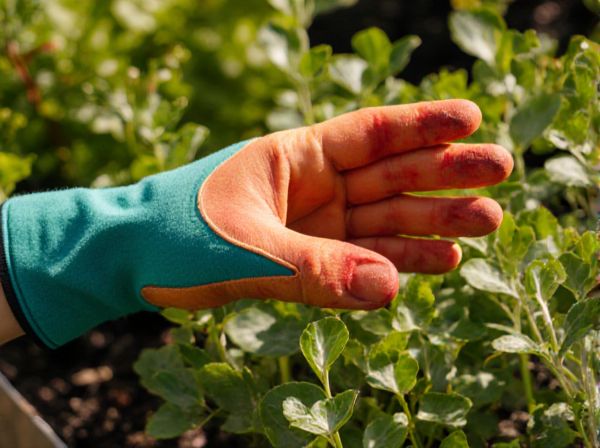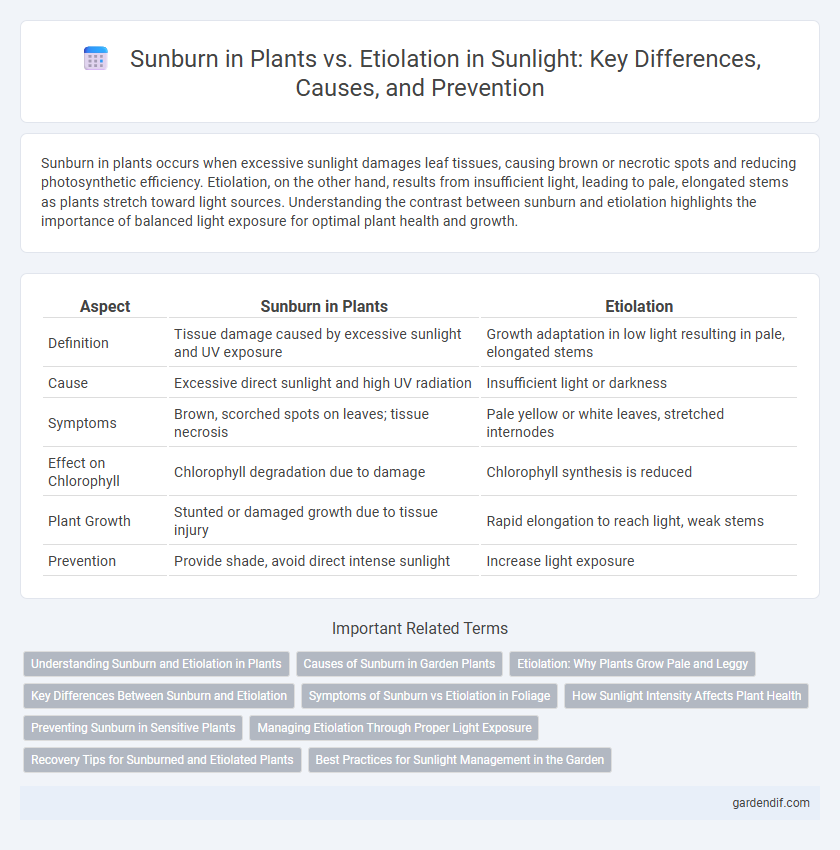
Sunburn in plants vs etiolation Illustration
Sunburn in plants occurs when excessive sunlight damages leaf tissues, causing brown or necrotic spots and reducing photosynthetic efficiency. Etiolation, on the other hand, results from insufficient light, leading to pale, elongated stems as plants stretch toward light sources. Understanding the contrast between sunburn and etiolation highlights the importance of balanced light exposure for optimal plant health and growth.
Table of Comparison
| Aspect | Sunburn in Plants | Etiolation |
|---|---|---|
| Definition | Tissue damage caused by excessive sunlight and UV exposure | Growth adaptation in low light resulting in pale, elongated stems |
| Cause | Excessive direct sunlight and high UV radiation | Insufficient light or darkness |
| Symptoms | Brown, scorched spots on leaves; tissue necrosis | Pale yellow or white leaves, stretched internodes |
| Effect on Chlorophyll | Chlorophyll degradation due to damage | Chlorophyll synthesis is reduced |
| Plant Growth | Stunted or damaged growth due to tissue injury | Rapid elongation to reach light, weak stems |
| Prevention | Provide shade, avoid direct intense sunlight | Increase light exposure |
Understanding Sunburn and Etiolation in Plants
Sunburn in plants occurs when excessive sunlight damages leaf tissues, causing discoloration, necrosis, and reduced photosynthesis, often linked to ultraviolet radiation and heat stress. Etiolation results from insufficient light exposure, leading to elongated stems, pale leaves, and weak growth due to chlorophyll deficiency as plants stretch towards light sources. Understanding these conditions helps optimize plant health by balancing light intensity and duration for photosynthetic efficiency and stress avoidance.
Causes of Sunburn in Garden Plants
Sunburn in garden plants is caused primarily by excessive exposure to intense sunlight, leading to tissue damage and cellular dehydration. High temperatures combined with direct UV radiation disrupt chlorophyll and cellular membranes, often resulting in bleached or scorched leaf surfaces. Unlike etiolation, which is driven by insufficient light causing elongated stems and pale leaves, sunburn directly damages plant tissues due to overexposure to sunlight.
Etiolation: Why Plants Grow Pale and Leggy
Etiolation occurs when plants receive insufficient sunlight, leading to pale, elongated, and weak stems as they stretch toward light sources. This adaptive response reduces chlorophyll production, causing leaves to appear yellowish or pale compared to healthy green foliage. Unlike sunburn, which damages plant tissue through excessive UV exposure, etiolation is a survival mechanism triggered by low light conditions.
Key Differences Between Sunburn and Etiolation
Sunburn in plants results from excessive exposure to intense sunlight, causing damaged leaf cells, brown or bleached patches, and hindered photosynthesis, whereas etiolation occurs due to insufficient light, leading to elongated, pale, and weak stems as plants stretch to reach light sources. Sunburn typically manifests as localized tissue injury with chlorophyll degradation, while etiolation is characterized by adaptive morphological changes to maximize light capture. Understanding these key differences aids in effective plant care and stress management in horticulture.
Symptoms of Sunburn vs Etiolation in Foliage
Sunburn in plants manifests as bleached, brown, or crispy leaf areas resulting from excessive exposure to intense sunlight and UV radiation, causing cellular damage and necrosis. Etiolation symptoms include elongated, pale stems and smaller, yellowish leaves due to insufficient light, as plants stretch toward a light source to maximize photosynthesis. While sunburn damages foliage directly by causing tissue death, etiolation alters plant morphology and coloration as a stress response to light deprivation.
How Sunlight Intensity Affects Plant Health
High sunlight intensity can cause sunburn in plants, leading to damaged leaf tissues, reduced photosynthesis, and impaired growth. In contrast, low sunlight intensity often results in etiolation, where plants exhibit elongated stems and pale leaves as they stretch toward the light source. Optimal sunlight intensity is crucial to maintaining plant health by balancing energy absorption and preventing stress-related damage.
Preventing Sunburn in Sensitive Plants
Preventing sunburn in sensitive plants involves providing adequate shade and gradual exposure to sunlight to avoid sudden damage to plant tissues. Using shade cloths with 30-50% light filtration helps reduce direct sun exposure while maintaining photosynthesis efficiency, minimizing risks of leaf scorching and cellular damage. Proper watering and mulching also support plant health by improving hydration and temperature regulation, crucial for preventing sunburn compared to etiolation, which results from insufficient light.
Managing Etiolation Through Proper Light Exposure
Etiolation in plants results from insufficient sunlight, causing elongated stems, pale leaves, and weak growth as the plant stretches toward light sources. Proper light exposure prevents etiolation by providing adequate intensity and duration, promoting robust chlorophyll development and compact structure. Managing light conditions with balanced natural or artificial sunlight ensures healthy plant morphology and reduces susceptibility to sunburn, which occurs from excessive and intense direct sunlight exposure.
Recovery Tips for Sunburned and Etiolated Plants
Sunburned plants require gradual shading and consistent watering to repair damaged tissues and prevent dehydration, with applications of foliar sprays containing antioxidants aiding recovery. For etiolated plants, reintroduce them slowly to natural light to stimulate chlorophyll production, while maintaining moist soil to support new growth. Balanced fertilization with nitrogen and potassium boosts overall plant health, enhancing resilience to future light stress.
Best Practices for Sunlight Management in the Garden
Sunburn in plants, caused by excessive direct sunlight, leads to leaf scorch, browning, and reduced photosynthesis, whereas etiolation results from insufficient light, causing leggy, pale growth. To optimize sunlight management in the garden, place sun-sensitive plants like tomatoes and peppers in partial shade during peak afternoon hours and use shade cloths to prevent leaf damage. Regular monitoring of sunlight intensity and gradual acclimatization of plants to increased light exposure enhances growth while minimizing stress and sunburn risk.
Sunburn in plants vs etiolation Infographic

 gardendif.com
gardendif.com